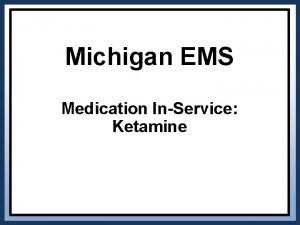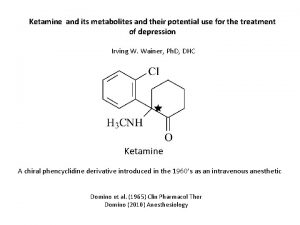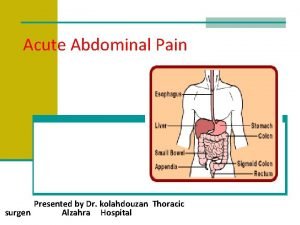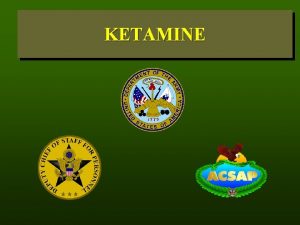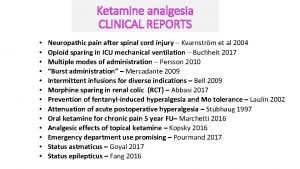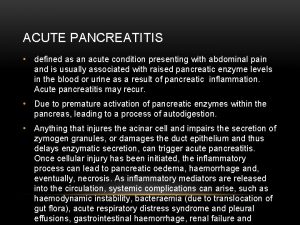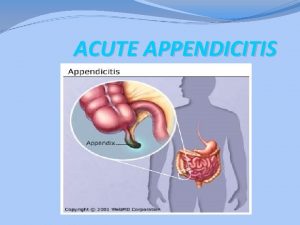Ketamine for Acute Pain Pain Pain is defined














- Slides: 14

Ketamine for Acute Pain

Pain • Pain is defined as suffering or feeling of discomfort • In EMS, usually caused by acute injury or illness • Pain can be physical, emotional, or mental • EMS faces all types of pain and can administer medications to help relieve physical pain

Challenge of Treating Pain • Each person tolerates pain uniquely • No single agent works uniformly for everyone • Subjective assessment • Acute pain can turn into chronic pain • Long-term narcotics can lead to addiction and mental pain

Why do we need another pain medication? • Opioid crisis • Many people have adverse effects to narcotics • Addiction potential • Limited non-narcotic parenteral agents • Treating pain is humane

Goals of care • Adequate relief of pain • Safe medication administration

Current Treatment Options • Parenteral narcotics • Aspirin • There are no other agents permitted for prehospital analgesia in the State of California

Ketamine – a new treatment • Increasing use for analgesia in emergency departments • Administered as an IV infusion slowly over 5 minutes • Lower dosage than for sedation/intubation • Hemodynamic stability • Safe and effective with rapid onset and short duration

Ketamine – side effects • Most common is nausea with analgesic doses • Other side effects if using high dose ketamine: • • Laryngospasm Tachycardia Hypertension Increased salivation

Ketamine for Acute Pain • Patients who are 15 years or older with acute traumatic or burn injury, a GCS of 15, an analog pain score of at least 5 (on a scale of 110), and who are in need of an analgesic, are eligible to receive ketamine

Exclusions • Patients should NOT receive ketamine if any one of the following is true: • • • GCS 14 or under Pregnancy Known or suspected alcohol or drug intoxication Known allergy to ketamine Has received narcotic analgesic in past 6 hours Pain score not above 5 prior to administering Ketamine

Ketamine Administration and Dosage • Dose of 0. 3 mg/kg with a maximum of 30 mg • You must approximate the weight of the patient • Ketamine is most commonly supplied as a 10 mg/ml, 50 mg/ml or 100 mg/ml solution • Key to administration and decreasing side effects is a slow IV infusion over at least 5 minutes • You can use ondansetron for nausea if necessary • DO NOT administer narcotic analgesic in addition to Ketamine • DO NOT administer Ketamine IM nor IN

Mixing Ketamine in an IV infusion bag • Draw up the appropriate amount of Ketamine BASED ON THE CONCENTRATION OF KETAMINE carried • For example, a 30 mg dose would be the following: • 3 mls of a 10 mg/ml concentration • 0. 6 mls of a 50 mg/ml concentration • 0. 3 mls of a 100 mg/ml concentration • Add the ketamine to a 50 cc bag of normal saline or D 5 W (note: Ketamine is stable in BOTH) • Attach an adult drip set (10 gtts/ml) • Run the infusion over approximately 5 minutes (120 gtt/min or 2 gtt/sec)

Post-Administration • Relief starts quickly after administration • You must record initial pain score (scale of 1 to 10) • Pain scores should be reported at administration and every 5 minutes thereafter • Must document weight, dosage, and pain scores in patient care record • You may give one additional dose of 0. 3 mg/kg (max single dose = 30 mg) as an IV infusion if, after 15 minutes, the pain score remains at or above 5. • Do Not administer narcotic analgesic if Ketamine has been given • Call base hospital physician if any questions or concerns

Questions? • Please contact the EMS Agency for any questions • Any complications should be reported immediately • You may freely utilize the base hospital physicians for any medical direction

